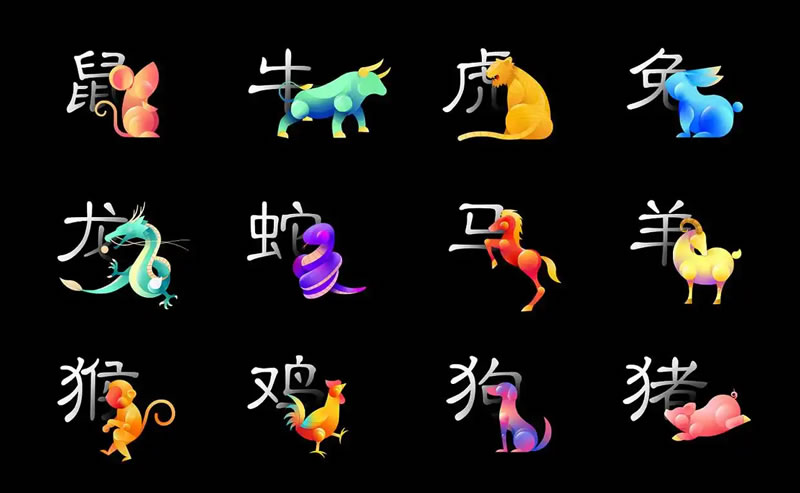Chinese zodiac, order list!
hellozkokl
The twelve Chinese zodiac signs, also known as the phases of the genus, are the twelve animals in China that match the twelve earthly branches with the year of a person’s birth, including the rat, ox, tiger, rabbit, dragon, snake, horse, goat, monkey, rooster, dog, and pig.
The origin of the zodiac is related to animal worship. According to Hubei Yunmeng Sleeping Tiger Land and Gansu Tianshui Fumatan unearthed Qin Jian can be seen, the pre-Qin period that there is a relatively complete system of the Chinese zodiac exists. The earliest document that recorded the same twelve zodiac signs as in modern times was Wang Chong’s “Lun Heng” in the Eastern Han Dynasty.

With the development of history gradually fused into the concept of mutual beliefs, reflected in the marriage, life, annual fortune, etc., each of the Chinese zodiac has a rich legend, and in this way to form a conceptual interpretation system, which has become the image of the philosophy of folk culture, such as marriage on the phases of the genus, temple prayers, the year of the birth of a child, and so on. In modern times, more people use the Chinese zodiac as a mascot for the Chinese New Year and as a symbol for entertainment and cultural activities.
Below is the order of the 12 zodiac signs and their details:
- Rat: The Rat is the first of the twelve zodiac signs, representing resourcefulness, flexibility and acumen. In traditional Chinese culture, rats also symbolize wealth and prosperity because of their ability to reproduce quickly and have a strong vitality.
- Ox: The Ugly Ox represents hard work, endurance and resilience. In Chinese agricultural society, the Ox is an important tool for plowing the fields and therefore also symbolizes a good harvest and prosperity.
- Tiger: The Tiger is a symbol of strength and courage. In Chinese culture, the tiger also represents majesty and dignity, and is often used to symbolize armies and force.
- Rabbit: The Rabbit represents agility, gentleness and happiness. In traditional Chinese culture, the Rabbit also symbolizes longevity and good fortune, as the word “Rabbit” harmonizes with the word “Tou”, implying a bright future.
- Dragon: The dragon is one of the most mysterious and symbolic animals in Chinese culture. It represents power, honor and good fortune, and is often used to symbolize the emperor and the royal family. In Chinese mythology, the dragon is also the god of rain and water, able to control the weather and water sources.
- Snake: The Snake represents wisdom, mystery and acumen. In Chinese culture, snakes also symbolize wealth and longevity, as their form resembles the ancient patterns of money and longevity.
- Horse: The Noon Horse represents spiritedness, freedom and strength. In traditional Chinese culture, the horse also symbolizes success and progress, as “Horse to Success” is a common Chinese blessing.
- Sheep: The Sheep represents gentleness, kindness and harmony. In Chinese culture, the sheep also symbolizes good fortune and happiness, as the word “sheep” is synonymous with the word “Xiang”. In addition, the sheep is one of the traditional sacrificial animals in China.
- Monkey: The Shen Monkey represents wit, intelligence and flexibility. In Chinese culture, the monkey also symbolizes joy and happiness, as it is active and clever, and often brings laughter to people.
- Chicken: The Rooster represents diligence, punctuality and bravery. In traditional Chinese culture, the chicken also symbolizes good fortune and happiness, as the word “chicken” harmonizes with the word “good fortune”. In addition, the chicken is also one of the traditional Chinese animals for telling the time. 11.
- Dog: The Dog represents loyalty, bravery and faithfulness. In Chinese culture, the dog is one of the most loyal friends of mankind and therefore also symbolizes friendship and loyalty.
- Pig: The Hai Pig represents hard work, kindness and open-mindedness. In traditional Chinese culture, pigs also symbolize a good harvest and prosperity, as they are one of the most important domestic animals in agricultural societies.
The twelve signs of the Chinese zodiac not only occupy an important place in Chinese culture, but also have a wide influence in other Asian countries and regions. Each zodiac sign has its own unique symbolism and cultural connotation, and they are closely related to people’s lives and are widely used in various cultural activities and folk traditions.
In modern society, the images and meanings of the twelve Chinese zodiac signs have gone beyond traditional culture and become important elements in people’s entertainment, consumption and socialization. For example, during the Chinese New Year, people buy mascots and decorations related to their Chinese zodiac to celebrate the New Year, and on social media, people share anecdotes and blessings related to their Chinese zodiac to promote friendship and interaction.
In conclusion, the twelve Chinese zodiac signs are an important part of traditional Chinese culture, which represent people’s reverence and gratitude to nature and animals, and also harbor people’s aspirations and pursuit of a better life. By understanding and passing on the cultural connotation and spiritual value of the twelve Chinese zodiac signs, we can better carry forward the excellent traditional Chinese culture and promote cultural exchanges and national unity.